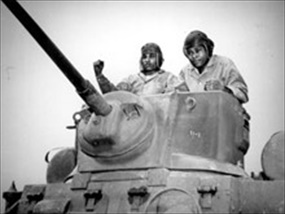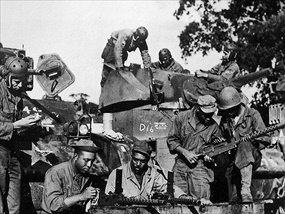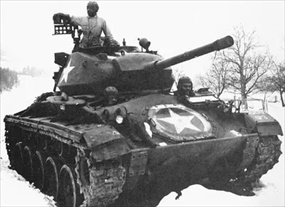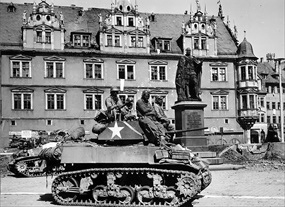761st BLACK PANTHERS TANK BATTALION CREATED
Washington, D.C. • March 15, 1942
On this date in 1942 the U.S. War Department established the second of 3 tank battalions in what became the Fifth Armored Group, a predominately African American armored formation that served with distinction in World War II. The 3 black tank battalions were the 758th, activated in January 1941; the 761st, activated over a year later on the first of April 1942; and the 784th activated the same year. Of the 3 black battalions serving in the European Theater, without question the 761st, known as the Black Panthers after the unit’s distinctive insignia, is the most famous owing to its connection with Lt. Gen. George S. Patton’s Third U.S. Army.
Immediately before and during World War II, U.S. military leaders had reservations about assigning African American soldiers, sailors, and Marines to combat duty. Bigotry against black people factored into almost all aspects of life in the U.S. That included the armed forces, despite the 1940 Selective Training and Service Act prohibiting discrimination “against any person on account of race and color.” “As fighting troops, the Negro must be rated as second-class material,” declared a colonel in the 92nd Infantry Division, “this primarily [due] to his inferior intelligence and lack of mental and moral qualities.” For most of the war the 1.2 million black men and women in uniform were relegated to noncombat roles such as cooks and messmen, stevedores, truck drivers, mechanics, and medical and office orderlies.
Lt. Gen. Lesley J. McNair, Army Ground Forces commander, successfully argued that “colored” (the term in use at the time) units should be employed in combat. At McNair’s suggestion, the U.S. Army began experimenting with segregated combat units in 1941. The next year, on April 1, 1942, a half month after the 761st was constituted, the U.S. Army’s second African American tank unit was activated at Camp Claiborne, Louisiana.
The 761st Tank Battalion trained for over 2 years at Camp Claiborne and Camp Hood in Texas before it received orders for overseas duty. (A unit historian theorized the drawn-out training was due to the Army not knowing what to do with black forces.) The tankers shipped out to England in early September 1944 and landed on the European continent at Omaha Beach in Normandy, France. The battalion was eventually assigned to Patton’s Third Army the next month. According to a widely circulated story, Patton, who commanded the 2nd Armored Division when the U.S. entered World War II, personally asked for the Black Panther Battalion, whose motto was “Come Out Fighting.” Patton reportedly contacted the War Department in Washington, D.C., requesting more tanks—the best available. The only tank unit left, he heard back, was made up of “colored” troops. “Who the [profanity deleted] asked for color?” the 3‑star general exploded. “I asked for tankers.” So, the 760 black men and white officers of the 761st, equipped with 54 medium M4 Sherman tanks in 3 companies and a light company of 15 smaller M5 Stuart tanks, proudly embraced their summons to battlefield greatness.
Beginning in November 1944, the 761st Tank Battalion engaged the enemy for 6 months straight, spearheading many of Patton’s offensives. The tankers slowed German resupply and took pressure off other units under siege at the Battle of the Bulge (December 16, 1944, to January 25, 1945). The 761st saw fighting in a half-dozen European countries, including France, Germany, and Austria. No other unit fought for so long and so hard without respite. The 761st is credited with inflicting 130,000 casualties, capturing 30 towns, liberating tens of thousands of inmates from concentration camps—and making history as the first African American armored unit in combat. The battalion received a Presidential Unit Citation for its actions. In addition, a large number of individuals received medals, including 1 Congressional Medal of Honor (posthumously), 7 Silver Stars, and 246 Purple Hearts. Eight enlisted men received battlefield commissions.
761st Tank Battalion aka “Patton’s Panthers” During World War II
 |  |
Left: Two African American tankers in an M5 Stuart Light Tank during training exercises, c. 1943. The 761st was formed in early 1942 in Louisiana, eventually moving to Camp Hood, Texas, where the men trained for over 2 years, first with M5 Stuart light tanks and later with M4 Sherman medium tanks. Training extended beyond the typical length, possibly because Army commanders hesitated to give black tankers the chance to prove their worth in combat. Ironically, the extra training proved invaluable when the 761st engaged German armor in combat. Once on the battlefields of Europe, black tankers proved they were just as good, if not better, than white tankers.
![]()
Right: Soldiers from the 761st Tank Battalion’s Dog Company check equipment before leaving England for combat in France in the fall of 1944. As component battalions in the Fifth Armored Group, the 758th, 761st, and 784th battalions were separated and reassigned to different divisions to meet manpower demands. Originally assigned to Lt. Gen. William Simpson’s Ninth U.S. Army, the 761st was reassigned to Patton’s Third Army on October 2. Initially Patton was a skeptic of African American tankers in combat, writing to his wife that “colored soldier[s] cannot think fast enough to fight in armor.” Yet the pistol-packing general extended a welcoming hand to the men of his all-black tanker battalion. In a rousing speech on October 28, 1944, just before sending the 761st into combat against the German enemy, Patton jumped onto the hood of an armored car and, in his curiously high-pitched voice, said: “Men, you are the first Negro tankers to ever fight in the American army. I have nothing but the best in my army. I don’t care what color you are, so long as you go up there and kill the Kraut. Everyone has their eyes on you and is expecting great things from you. Most of all, your race is looking forward to your success. Don’t let them down, and, damn you, don’t let me down. They say it is patriotic to die for your country. Well, let’s see how many patriots we can make out of those German SOBs.”
 |  |
Left: A tank crew of 4 from the 761st halt their M24 Chaffee light tank in a snowy field near Bastogne during Patton’s historic efforts to relieve soldiers of the 101st Airborne Division and as well as elements of his own Ninth and Tenth Armored Divisions besieged there. It was during this 5‑week encounter, famously known as the Battle of the Bulge, that M24 Chaffees first saw action. Patton employed M24s for the Third Army’s advance into Southern Germany, Austria, and Czechoslovakia in April 1945. Chaffee light tanks with their distinctive “>” front hull replaced older M5 Stuart light tanks.
![]()
Right: M5 Stuart tanks from the 761st Tank Battalion await orders to clear out Nazi machine gun nests in the Northern Bavarian city of Coburg, April 25, 1945. Because of their feeble armament and armor, M5s were perfectly matched for this assignment. Coburg may be best known as one of the capitals of the Duchy of Saxe-Coburg, whence hailed Prince Albert, who married Queen Victoria in 1840.
The Story of the 761st “Black Panther” Tank Battalion
![]()

 History buffs, there is good news! The Daily Chronicles of World War II is now available as an ebook for $4.99 on Amazon.com. Containing a year’s worth of dated entries from this website, the ebook brings the story of this tumultuous era to life in a compelling, authoritative, and succinct manner. Featuring inventive navigation aids, the ebook enables readers to instantly move forward or backward by month and date to different dated entries. Simple and elegant! Click
History buffs, there is good news! The Daily Chronicles of World War II is now available as an ebook for $4.99 on Amazon.com. Containing a year’s worth of dated entries from this website, the ebook brings the story of this tumultuous era to life in a compelling, authoritative, and succinct manner. Featuring inventive navigation aids, the ebook enables readers to instantly move forward or backward by month and date to different dated entries. Simple and elegant! Click 











